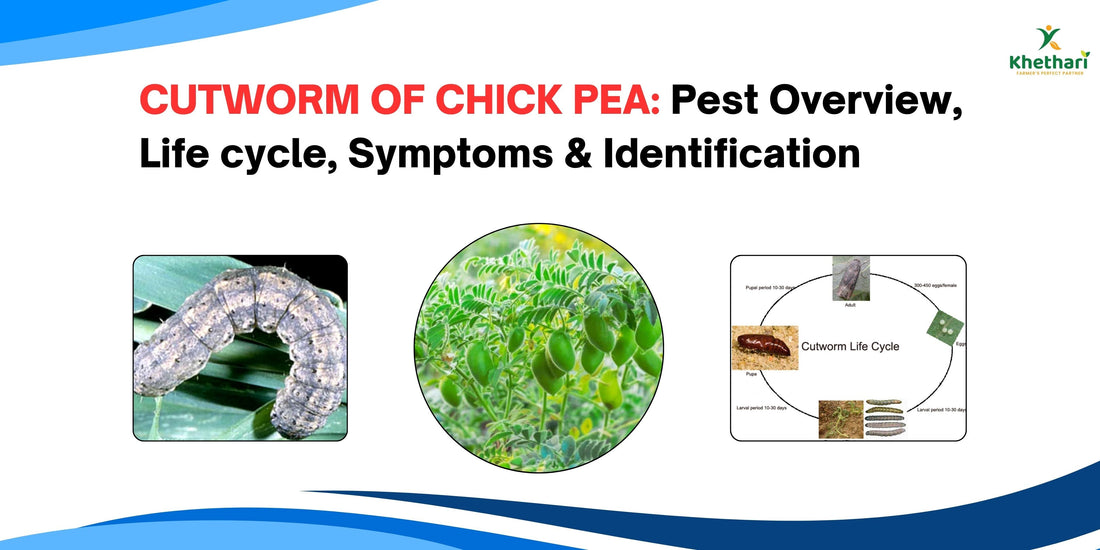
CUTWORM OF CHICK PEA: Pest Overview, Life cycle, Symptoms & Identification
1. Pest Overview
Scientific Name & Taxonomy:
- Order: Lepidoptera
- Family: Noctuidae
- Genus: Agrotis
- Common species affecting chickpea: Agrotis ipsilon (Black cutworm), Agrotis segetum (Turnip cutworm)
Cutworms are nocturnal moth larvae that live in soil and feed on the stems and foliage of young plants. Their name comes from their habit of cutting seedlings at the soil surface. Adult moths are weak fliers, active mainly at night, and lay eggs near host plants or in crop residues.
Biology and Life Cycle:
- Egg: Tiny, spherical, whitish eggs laid singly or in clusters on soil or plant debris. Incubation lasts 5–10 days depending on temperature and humidity.
- Larva: The larval stage is the damaging stage, lasting 3–5 weeks. Larvae are smooth, cylindrical, and vary in color from grey to black, often with subtle longitudinal stripes. When disturbed, they curl into a “C” shape. Larvae feed at night, hiding in soil or under debris during the day.
- Pupa: Pupation occurs in soil at 2–5 cm depth. Pupal stage lasts 1–2 weeks. Pupae are brown, cylindrical, and immobile.
- Adult: Adult moths emerge from soil, mate, and live for 1–2 weeks. They are nocturnal, weak fliers, and are responsible for dispersal and egg-laying.
Behavioral Patterns:
- Larvae feed mostly at night, hiding during the day under soil clods or plant residues.
- Prefer seedlings and young plants; can cut the stem near soil surface.
- Activity peaks in early crop stages, especially in warm, moist conditions.
2. Host Range
Cutworms have a wide host range:
- Primary host: Chickpea (Cicer arietinum)
- Other pulses: Lentil, pea, pigeon pea
- Occasional hosts: Cereals (wheat, maize), oilseeds, vegetables like tomato, cabbage, and mustard
This wide host range makes crop rotation and field sanitation important to reduce infestation pressure.
3. Symptoms & Identification
Field Symptoms:
- Sudden wilting of seedlings or young plants.
- Irregular patches of dead plants across the field.
- Leaf feeding by larger larvae: small holes or ragged edges.
- “Cut-off” stems lying on soil surface, often mistaken for poor germination.
Appearance of Larvae:
- Length: 2–5 cm when fully grown.
- Color: Grey, brown, or black with subtle longitudinal stripes; smooth, cylindrical body.
- Distinguishing feature: curls into a “C” shape when disturbed.
Signs in the Field:
- Seedlings cut near ground level.
- Uneven crop stand due to patchy seedling loss.
- Soil surface may show small depressions or holes where larvae hide during day.
- Early morning or late evening inspection often reveals active larvae feeding.
4. Conditions Favorable for Infestation
Cutworms thrive under the following conditions:
- Soil: Loose, well-drained loamy or sandy soils favor larval movement. Heavy clay reduces mobility.
- Moisture: Moderate soil moisture promotes survival; extremely dry soil reduces larval activity.
- Temperature: 20–30°C accelerates development; cold slows down growth.
- Crop Stage: Early seedling stage is most vulnerable; older plants can tolerate minor feeding.
- Crop Residue: Presence of crop debris or weeds provides shelter and alternative food for larvae.
5. Economic Impact
- Infestation can cause 10–30% seedling mortality in severe cases.
- Uneven crop stands lead to patchy growth, making mechanical harvesting difficult and reducing overall yield.
- Early detection and management are critical to avoid substantial losses.
- Even small infestations in the early stage can affect plant population and final pod yield.
6. Monitoring & Scouting
Early Detection:
- Inspect fields daily during seedling emergence.
- Look for wilting seedlings with stems cut at soil level.
Sampling Methods:
- Randomly select 5–10 sites per hectare.
- Count damaged seedlings and larvae in a 1 m² area.
- Threshold for action: 3–5 larvae per m² at seedling stage may require control.
Traps:
- Light traps: Monitor adult moth activity.
- Pheromone traps: Can detect adult emergence and population peaks (species-specific).
Field Observation Tips:
- Check soil surface for larvae hiding during the day.
- Evening or night inspections increase detection rates.
- Observe crop edges, low-lying patches, and fields near previous host crops for early signs.
7. Integrated Pest Management (IPM)
Cultural Control:
- Deep plowing before sowing to expose pupae and larvae to predators and sun.
- Remove crop residues and weeds that serve as alternate hosts.
- Timely sowing to avoid peak cutworm activity.
- Use trap crops (mustard, maize) along field borders.
Biological Control:
- Predators: Ground beetles, ants, spiders feed on larvae.
- Parasitoids: Trichogramma spp. attack eggs.
- Entomopathogens: Fungal pathogens (Beauveria bassiana), bacterial sprays (Bacillus thuringiensis or Bt) are effective against larvae.
Chemical Control:
- Recommended when infestation exceeds economic threshold.
Example insecticides:
Carbaryl 50% WP: 2 g/L water
Chlorantraniliprole 18.5% SC: 0.4–0.5 ml/L water
- Apply in the evening when larvae are active; avoid drift to non-target areas.
- Follow safety precautions: gloves, mask, avoid spraying near water sources.
Preventive Measures:
- Seed treatment with systemic insecticides can reduce early larval attack.
- Maintain field hygiene and remove weeds.
- Avoid late sowing coinciding with adult moth flight peaks.
8. Farmer Advisory Tips
- Inspect fields early morning or late evening for active larvae.
- Look for uneven patches, cut seedlings, and leaf feeding signs.
- Keep fields weed-free and remove plant debris to reduce hiding sites.
- Combine cultural, biological, and chemical methods for sustainable management.
- Replant damaged areas promptly to maintain uniform crop stand.
- Educate laborers and farm workers to identify cutworm larvae and damage signs.
Quick Do’s and Don’ts:
- ✅ Do: Monitor regularly, plow before sowing, use trap crops.
- ❌ Don’t: Overuse pesticides, delay sowing, leave weeds or debris near fields.

